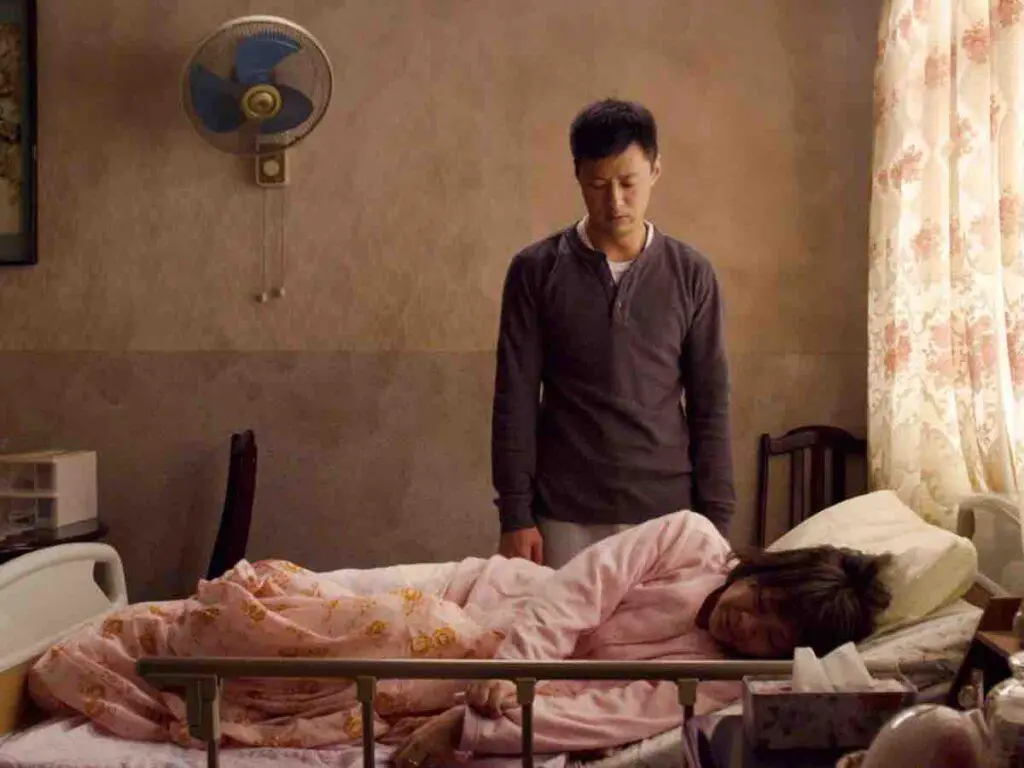“Am I the abnormal one?” The question Mad World posits is one of reflection. Chun Wong’s debut feature tells the compelling story of Tung, a former financial analyst who gets hospitalized for bipolar disorder. Thrust into the care of his estranged father, Tung’s attempt to reintegrate into the society is startlingly devastating. It leaves us to ponder over the question: if not Tung, who is the ‘abnormal’?
Mental illness is a subject rarely given space on the Hong Kong cinematic screen. Chun Wong and screenwriter Florence Chan, however, tackle it bravely, brilliantly illuminating the experience of the afflicted. Comprising largely of interviews with bipolar patients, healthcare workers, relatives, caretakers, the script brings the film close to reality despite being a work of fiction. As Tung struggles to integrate into the society, it becomes apparent that mental illness is no different from the many social ills that plague our daily lives.
Tung starts to blur and converge the lines between the ‘normal’ and the ‘abnormal,’ and the film confronts the widespread stigma against mental illnesses as we are led to question the labels we place on individuals with mental illnesses. Brilliantly portrayed by Shawn Yue, we, as the audience, ache for Tung’s lived reality as an otherwise normal man regulated to the margins of society due to his heightened sensibilities, tortured by his past and his illness.
Performances
While being largely sympathetic towards the topic of mental illness, Mad World maintains its grim reality of the different issues and consequences related to it. Acting veteran Eric Tsang expertly depicts the uneducated well-meaning father stumbling through his attempts to make amends for his absence while grappling to understand the complexities of bipolar disorder. His frustration parallels that of Tung’s in the flashback shots of his time as his mother’s caretaker, which rawly depicts the distressing experience of those supporting individuals with mental illness.
Yet, we are reminded continuously that the distress caused is often an uncontrollable symptom of individuals who are very much tormented by themselves. Elaine Jin’s gut-wrenching performance as an ill elderly woman lashing out through her pain triggers sympathy for both her and Tung, just as Tung’s own outbursts at his father in his depressive state does. Tung is evidently both his father and mother, patient and caretaker, and it is through the conflation of these roles in his body that the film criticizes the practice of reducing individuals to stereotypes built on prejudice — one does not become less of an individual as a patient.
The role reversal when it is Tung’s turn to care for his father, therefore, cements the point that those with mental illness are still fully functioning human beings. Wong’s direction and Chan’s script create an easy palatability, prefacing the simultaneous and conflicting feelings of hope and despair coloring the lived reality of individuals with mental illness and those around them.
The Irony Of it All
Accompanied by Yusuke Hatano’s nostalgic and somber score, these complex feelings are elevated, shedding light on the central topic and the stigma associated with it, helping viewers understand the depth and nature of the disorder.
Hong Kong is shown as a society obsessed with appearances. What counts as successful has a rigid definition allowing little space for failure. Tung’s mother only acknowledges his little brother, who “graduated from the best school and has a great job”, his young neighbor is taught that he needs “good grades to climb up the social ladder”, and has internalized that a job that requires hands equates to a “good for nothing” person. However, this seemingly foolproof formula for success — education — becomes ironic as the film underlines how similar the educated and the uneducated in society are in their ignorance of mental illness.
Tung encounters strong prejudice and discrimination wherever he goes. In fact, it seems the uneducated are better off than the educated understanding and accepting this complex notion. Tung’s father and his young neighbor, who isn’t quite social, seem to be the only ones capable of empathy. It’s ironic that it’s in the company of these two individuals — with the least mobility in their shared lack of education — that Tung is allowed more freedom and space to exist as himself despite his illness.
Political Lens
The personal is made political as the film shows how mental health stigma stems from the nature of modern Hong Kong society. Tung’s experience is used as a lens to examine the larger cultural issues in Hong Kong. Society’s rejection of Tung as a part of ‘normalcy’ is communicated in the space he is regulated to.
The mise en scène of the subdivided flat Tung calls home after getting discharged amplifies his sense of suffocation. The tiny room — with only space for a bunk bed and a small foldable table — fits entirely into the frame of the lens; the obvious lack of space creates a sense of constriction reflecting Tung’s state of mind as he struggles to assimilate back into his society which seemingly has no space for him.
Therefore, society is presented as an unforgiving place for those who trip in the chase of capitalism — the pathway of individuals suffering from mental illness is a slippery slope as Tung is unable to get a job despite his extensive efforts. Thus, Tung is left jobless and stuck economically, much like his working-class father who can only take up physical jobs due to his lack of education. The subdivided flat then becomes no different from the mental care facility. While Tung may be back in civilization, he is still isolated as his peers and neighbors, and the society still sees him as an outcast. His father’s inability to help him or make amends highlights the grim reality of societal fragmentation: it is not only the ‘abnormal’ that are excluded, the economically disadvantaged live in the periphery as well.
Fragmented World
In an interview with Time Out, Wong expressed his dissatisfaction with modern society: “The truth is, the more time you spend with a person, the more you realize how inaccurate the stereotypes are. In a fast-paced society, we barely take the time to understand other people. Most of the time our perceptions are based on labels. “Since you’re doing this job, probably earn this much and hold this degree, I think you are this kind of person and I will get along with you.” You do that and other people are also doing the same to you. They never truly understand you or talk to the real you. This is a serious problem in a metropolis like Hong Kong where we never understand one another.
This fragmentation is communicated through the coloring of Mad World. Shots of the current time are tainted with cool tones of blue and green, communicating an overall sense of loneliness and isolation that highlight the disconnect in society. The mental health stigma shown in Mad World reveals how many perspectives that breed stereotypes, prejudice, and discrimination, stem from wilful ignorance in a fast-paced society unwilling to allow the time and space to understand others.
In fact, Hong Kong’s modern society is not unlike many other modern societies around the world. When we take a look at our own societies, we see the same fast-paced culture and the same quick reduction of people to labels that Mad World points out as an issue. While the film is evidently made for the local audience, it also grapples with universal issues of loneliness and isolation.
Conclusion
Mad World still holds much, if not more, relevance today as worsening health statistics continue to rise in Hong Kong and in urban cities around the world. Limited urban space continues to be an issue in Hong Kong, and with the advent of Covid-19, urban public space has become a larger necessity, as studies show those living in a city have a 40% higher risk of depression and over 20% risk of anxiety compared to those residing in rural areas. For a metropolis like Hong Kong with little public space to spare, studies have shown an increasing correlation between the lack of space and worsening mental health, evidently feeding Wong’s argument.
The film premiered at the 2016 Toronto International Film Festival and was both a critical and commercial success, with 23 wins and 31 nominations, grossing almost ten times its budget in theaters. Since then, the film has sparked several debates around mental illness and received multiple nods of approval from healthcare professionals, caretakers, and those suffering from mental illnesses.
It’s a mad world indeed. While the film is a consolation to those suffering silently, it also displays a longing for more humanity in a world quickly becoming less humane. A deconstruction of society, Mad World expertly and sensitively lays bare what it means to be an individual in a society in all its complexities, grappling with multiple themes of family dynamics, social hierarchies, and the individual through the lens of the marginalized individual with mental illness. We are forced to examine the appearances we put up despite our struggles and the attitudes we have towards those who fail or deny social performativity. In the end, we are led back to the question: what makes us ‘normal’?




